
Sharks may have been perceived as one of the most terrifying aquatic animals, as suggested by many thrillers we see on television. They have mostly been portrayed as epipelagic or living in the top region of the ocean, as their terrifying fins show on the surface of the water.
However, an entire world of deep-sea sharks also lives in the darkest parts of the water, and some of them are really big. "Deep sea" is actually very descriptive when grouping different species. It is generally referred to as anything below 1,000 fathoms or roughly 6,000 feet down, where no sunlight can reach but many unique creatures can thrive.
Meanwhile, the deepest layer of the ocean is called the "hadalpelagic" zone, which is 20,000-36,000 feet down.
AZ animals listed down 5 of the world's largest sharks venturing in or around the border of the deep sea.
5 Largest Deep Sea Sharks
5. Greenland Shark
These mysterious sharks live in the extremely cold waters around the northern pole, hence the name "Greenland". Due to the energy requirements in the cold, they are extremely slow-moving, but are still considered predatory by scientists. Generally, their sizes reach up to 24 feet and can stay around 3,900-foot depth, but they are often recorded at depths of up to 7,200 feet.
4. Megamouth Shark
According to Oceana, megamouth shark is a rare shark and a large species, reaching weights of 2700 pounds (1215 kg), but it is the smallest of the three species of filter-feeding sharks, behind the whale shark and the basking shark.
They have remarkably large, circular mouths, thus the name "Megamouth". Scientists believe they hunt for food in vertical columns, meaning they move up and down instead of around. The species have been seen occasionally around 600 feet, but can dive up to 15,000 feet in search of plankton and jellyfish.
3. Bluntnose Sixgill Shark
Often referred to as the cow shark, the bluntnose is an ancient shark that resides in the deep regions of the ocean. Scientists believe they are closer to the primitive Triassic sharks than any in the modern age. They have six gills instead of the standard five, thus the name "Sixgill". The species can grow up to 16 feet long, making them one of the largest deep-sea sharks in the world.
2. Pacific Sleeper Shark
Meanwhile, the giant "sleeper sharks" are similar to Greenland shark. Adult females can reach 12.1 to 14.1 feet in length, but it is speculated that the species' maximum length may be more than 23 ft, as per Shark Research Institute.
They generally prefer to inhabit the deep regions in the north Pacific and feed on a wide variety of surface and bottom animals, like seals and giant octopuses.
1. Goblin Shark
As the name suggests, the goblin shark has the creepiest look on this list. They are very ancient creatures and regarded as "living fossils" since they are the oldest species of shark alive.
Despite having evolved 125 million years ago, their looks did not seem to change at all - with a massive horn on their foreheads, haphazard teeth sticking out at odd angles, and a set of beady eyes. These "pink animals" can grow 12 feet long but are rarely seen. Scientists believe they are solitary, just like many other shark species.
Limited Known Information
Generally, there is limited information known about deepwater sharks, since some may even live at unimaginable depths. However, it is believed that they are extremely vulnerable to any fishing pressure and risk of serious decline if not protected or managed well.
© 2025 NatureWorldNews.com All rights reserved. Do not reproduce without permission.





